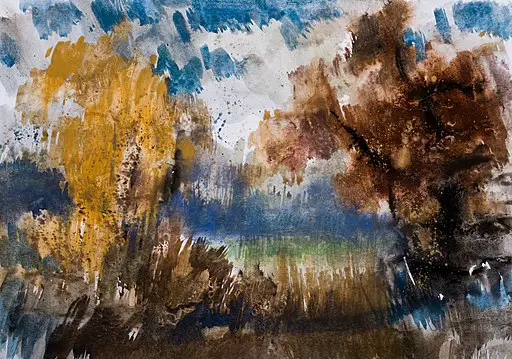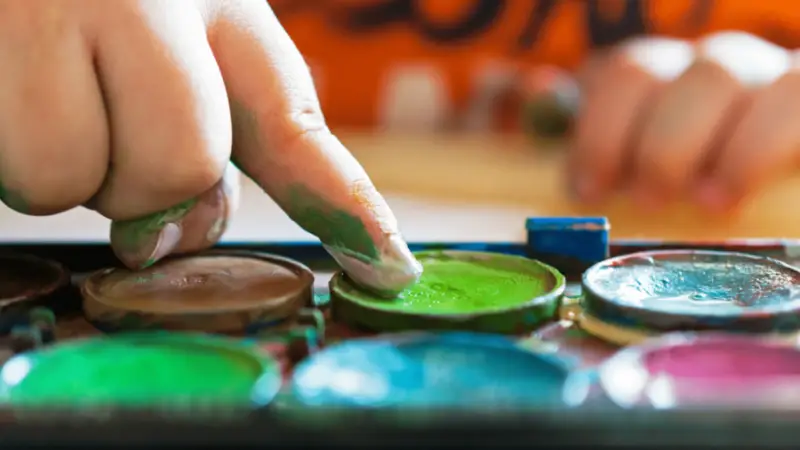Watercoloring is a fairly easy hobby to get into and can have beautiful results. Your enthusiasm can take a hit, though, when your colors keep turning out chalky and muddy. To fix this problem, the main question to ask is why your watercolors are chalky.
Table of Contents
- 1 Why Your Watercolors Are Chalky
- 2 How to Tell if Your Watercolors Are Chalky
- 3 When Your Watercolors Have a Cracked, Dry Texture
- 4 When You Can Scrape the Paint off the Paper
- 5 When Your Watercolor Paint Is Too Opaque
- 6 Why Are My Watercolors Chalky?
- 7 How Do I Fix My Chalky Watercolors?
- 8 Final Words
- 9 Sources
Why Your Watercolors Are Chalky
Three reasons why your watercolors can be chalky are 1/ low-quality paint, 2/ when your paint is premixed (and you don’t know what colors have been added), and 3/ when you have opaque paint, not translucent colors.
If you are a beginner at watercolors, it may be frustrating when the colors turn out chalky since multiple things can contribute to that. This article will explain how to tell if your watercolors are chalky, why they are chalky, and finally, how to fix chalky colors. Let’s dive into the first topic.
How to Tell if Your Watercolors Are Chalky
Especially if you are not familiar with watercolors, it may be hard to tell when your watercolors are chalky. If your painting looks off, but you don’t know why exactly, chalky paint may be the culprit. Let’s see how you can tell if your watercolors are chalky and not some issue with the color chart.
When Your Watercolors Have a Cracked, Dry Texture
Watercolors are supposed to look light and airy, and chalky watercolors will not have that effect. A good quality finish of watercolor paint is when the paint dries as a smooth, almost flat-looking texture. However, when it dries to have a cracked, rough texture, that’s when you can tell that it is chalky.
When You Can Scrape the Paint off the Paper
Not only does the paint look rough and dry, but when it is chalky, you can scrape the paint off. You can test this by taking your fingernail, a knife, or a palette knife and scraping the paint. If it scrapes off as a chalky texture, then chalky paint is your culprit.
When you try scraping a higher quality paint, the paint will not scrape off as easily. Student grade watercolors sometimes sit on the paper’s surface instead of absorbing correctly, which is why you can scrape it off. Even though higher quality paint will scrape off if you really try, it will usually require more pressure to come off the paper. It also will not be as flaky.
When Your Watercolor Paint Is Too Opaque
A final way to tell if your watercolors are chalky is to paint a black line on the canvas, then take another lighter color and paint over the black line. If your paint goes on thick and looks like it covers the black paint and sits on top of it instead of mixing with the color, then your colors are probably chalky. To be sure, take your fingernail or knife and scrape the area of the black paint to see if it scrapes off as described above.
It is important to remember that they will naturally be more chalky and thicker than translucent if you buy opaque watercolors. It is when your translucent watercolors are chalky that you have a problem.

Why Are My Watercolors Chalky?
Some Brands Don’t List What Pigments Are Already Mixed With the Paint of your Watercolor
Many people who do watercolor painting as a hobby often buy student-grade gouache to start with. This can be an issue when you try to mix the colors. Oftentimes with student grade paints, the colors are actually premixed. This can lead to chalky colors when you try to mix it yourself since you don’t know what colors it has been previously mixed with.
You Are Using Low-Quality Watercolor Paint
Some watercolor paints are just not good quality. If you buy the cheapest option, the paint may dry as a chalky and rough texture not because of how you mix it but because of the quality.
You Are Using Opaque Watercolors
Some brands don’t actually tell you what kind of watercolors you are purchasing. There are two main kinds of watercolors, which are opaque and translucent. If you expect a translucent application but have actually purchased opaque colors, you may think your paint is chalky since opaqueness is a sign of chalkiness.
If you are not sure whether you have opaque or translucent paint, do the black line test with a paint brush , as mentioned above. If the paint itself is not chalky but has covered the black line, you probably have opaque watercolor.
, as mentioned above. If the paint itself is not chalky but has covered the black line, you probably have opaque watercolor.

How Do I Fix My Chalky Watercolors?
Buff It With Paper Towel
Lindsey Decor says that a straightforward way to fix chalky, opaque colors is to grab some paper towel and buff it down. At first, the colors might look like they mix, but it will not create a muddy look. The finished result will look as if you have painted with high-quality translucent paint. Do notice that the type of watercolor paper you are using can also affect the finish.
says that a straightforward way to fix chalky, opaque colors is to grab some paper towel and buff it down. At first, the colors might look like they mix, but it will not create a muddy look. The finished result will look as if you have painted with high-quality translucent paint. Do notice that the type of watercolor paper you are using can also affect the finish.
Mix Colors on Paper Instead of in the Palette
When you mix your paints in the palette, the color can become muddy or chalky due to overmixing. To avoid chalky watercolors, mix the paint on the paper instead of in your palette. The palette can be difficult to mix on since it is usually already filled with paint and can even be stained with dark colors, making it difficult to know what colors are mixing.
A simple fix is to take a clean, white sheet of paper (grab a few so it will last the entire time you’re painting) and mix on that. This will make it easy to know what colors are mixing with what.
Adjust the Temperature of Your Paint Colors
Oftentimes, a pigment can be chalky due to colors that are too cold or too warm. First of all, colors can look chalky or muddy when the surrounding colors are much lighter than the color that looks chalky. When creating your masterpiece, make sure all of the values of the colors are similar (not overly contrasting).
Another way to fix your chalky paint colour is to add certain colors to adjust the temperature. If your color is too red and has an obvious warm tone when cool tones surround it, you can add cool tones (this would be coloring from the green-blue-violet side of the color wheel). This also works when you have cool tones that you want to add warmth to.
If your paint looks chalky because it looks overly bold and different in temperature from the rest of your painting, these tips will be sure to fix it.

Final Words
Chalky watercolors can turn a pretty painting into a muddy, mediocre mess. Fortunately, there are easy ways to both prevent and fix chalky watercolors.
Watercolors can be chalky for various reasons, including if the paint is low-quality if the paint was premixed, and finally, if you bought opaque paints instead of translucent. Another issue that derives from low quality and inexpensive paints is that your watercolor may crack . To prevent chalky paints, mix your colors on paper instead of the palette, buy translucent paint, and consider buying higher quality paint.
. To prevent chalky paints, mix your colors on paper instead of the palette, buy translucent paint, and consider buying higher quality paint.
From what this article has discussed, it is obvious that mixing your colors can be very important. If you are keen to learn specific recipes for mixing your watercolors, check out 1,500 Color Mixing Recipes for Oil, Acrylic & Watercolor: Achieve precise color when painting landscapes, portraits, still lifes, and more from Amazon. With this book, you will have an easy time avoiding chalky colors.
Recipes for Oil, Acrylic & Watercolor: Achieve precise color when painting landscapes, portraits, still lifes, and more from Amazon. With this book, you will have an easy time avoiding chalky colors.
Sources
- Adam Clague Fine Art: Avoiding Muddy & Chalky Skin Colors

- Strathmore: 7 Watercolor Tips for Beginners

- The Frugal Crafter: 10 Tips for Using Cheap Watercolor Supplies


